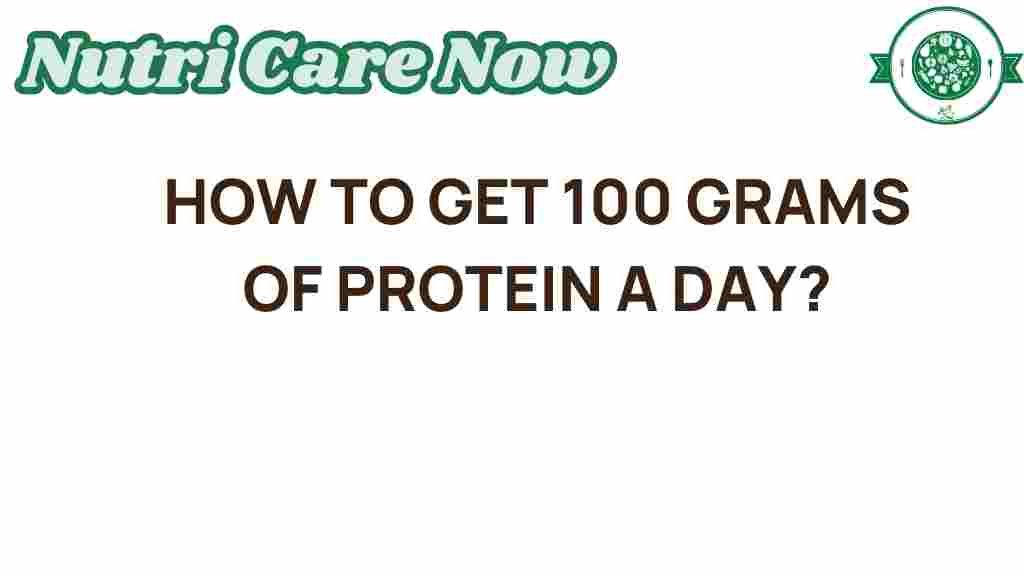Unlocking the Secrets: How to Get 100 Grams of Protein a Day
When it comes to healthy eating and fitness, achieving the right protein intake is crucial for muscle building, weight management, and overall well-being. If you’re aiming for 100 grams of protein per day, you’re on the right track to support your body’s needs. In this article, we’ll delve into effective dietary tips, explore various protein sources, and provide a comprehensive meal planning guide to help you reach your protein goals.
Understanding Protein: Why It Matters
Protein is an essential macronutrient that plays a vital role in various bodily functions, including:
- Muscle Repair and Growth: Protein is crucial for repairing tissues and building muscles, especially after workouts.
- Hormone Production: Proteins are involved in the synthesis of hormones that regulate many physiological processes.
- Immune Function: Antibodies, which help fight infections, are made of proteins.
- Enzyme Production: Many enzymes, which catalyze biochemical reactions in the body, are proteins.
With these functions in mind, it’s clear that maintaining adequate protein intake is essential for anyone focused on fitness and nutrition.
Step-by-Step: How to Plan for 100 Grams of Protein Daily
To successfully reach your protein target, follow these steps:
1. Calculate Your Needs
The first step in optimizing your protein intake is to calculate how much protein you actually need. A general guideline for active individuals is:
- 0.8 grams of protein per kilogram of body weight for sedentary individuals.
- 1.2 to 2.0 grams per kilogram for those engaged in regular exercise or muscle building.
For example, if you weigh 70 kg (154 lbs) and are active, aiming for around 84 to 140 grams of protein would be beneficial.
2. Identify Protein Sources
Next, identify high-quality protein sources to include in your diet. Here are some excellent options:
- Animal-Based Sources:
- Chicken breast (31g per 100g)
- Turkey (29g per 100g)
- Fish (e.g., salmon, 25g per 100g)
- Eggs (6g per egg)
- Dairy products (e.g., Greek yogurt, 10g per 100g)
- Plant-Based Sources:
- Lentils (9g per 100g cooked)
- Chickpeas (8g per 100g cooked)
- Quinoa (4g per 100g cooked)
- Nuts and seeds (e.g., almonds, 21g per 100g)
- Tofu (8g per 100g)
Incorporating a mix of these sources will not only help you reach your protein goals but also provide essential nutrients.
3. Meal Planning
Effective meal planning is key to achieving your protein intake. Here’s a sample daily meal plan that totals around 100 grams of protein:
- Breakfast:
- 3 scrambled eggs (18g)
- 1 slice whole-grain toast (4g)
- 1 cup Greek yogurt (20g)
- Snack:
- 1 protein shake (25g)
- Lunch:
- Grilled chicken salad with 150g chicken (46g)
- Mixed greens and veggies (2g)
- Snack:
- 1 ounce of almonds (6g)
- Dinner:
- Steamed fish with 150g (37g)
- Quinoa (8g)
This meal plan provides approximately 166 grams of protein, which can easily be adjusted to meet your specific needs.
Troubleshooting: Overcoming Common Challenges
Even with a solid plan, you may encounter challenges in reaching your protein goals. Here are some common issues and solutions:
1. Lack of Time
Solution: Meal prep on weekends. Cook larger portions and store them in the fridge or freezer for quick meals during the week.
2. Vegan or Vegetarian Diets
Solution: Focus on high-protein plant foods like beans, lentils, tofu, tempeh, and incorporate protein-rich grains like quinoa.
3. Dislike of Protein Sources
Solution: Experiment with different recipes and cooking methods. For instance, try smoothies, protein bars, or baked goods that incorporate protein powder.
4. Budget Constraints
Solution: Buy in bulk, choose lower-cost protein sources such as legumes, eggs, and canned tuna, and look for sales on meat and dairy products.
Additional Tips for Optimizing Protein Intake
Enhancing your protein intake doesn’t have to be complicated. Here are some additional tips:
- Incorporate Protein in Every Meal: Aim to include a source of protein in every meal and snack.
- Use Protein Supplements Wisely: Protein powders can be a convenient option, especially post-workout.
- Track Your Intake: Use apps or journals to monitor your protein consumption and stay accountable.
- Stay Hydrated: Adequate water intake is essential, especially when increasing protein in your diet.
For more detailed dietary guidelines and meal planning ideas, check out this comprehensive nutrition guide.
Conclusion
Reaching your goal of 100 grams of protein a day is entirely achievable with proper planning and knowledge of protein sources. By understanding your needs, utilizing various protein-rich foods, and following a structured meal plan, you can enhance your nutrition and support your fitness goals. Remember, consistency is key. With these tips and strategies, you’ll be well on your way to unlocking the secrets of effective protein intake.
For further insights into fitness and nutrition, visit our website for more articles and resources.
This article is in the category Diet and created by NutriCareNow Team
